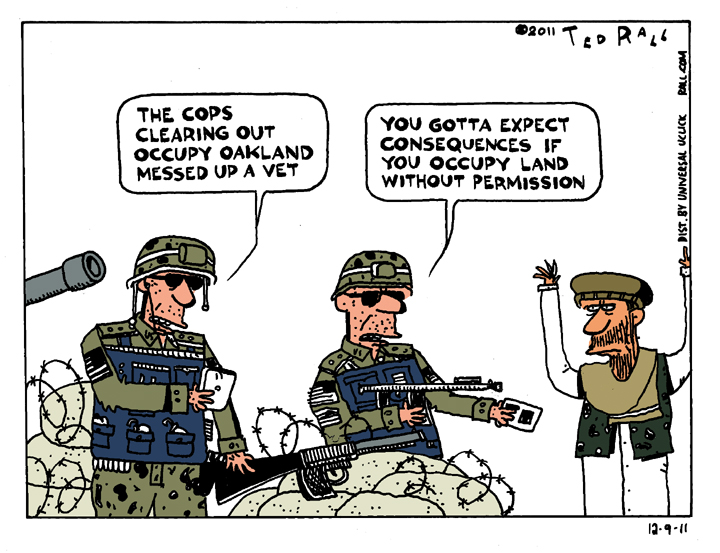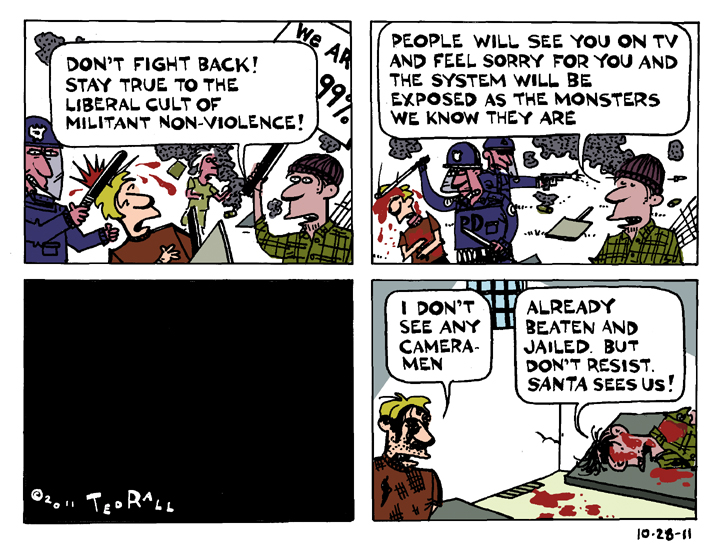Local police clear Occupy movement Occupiers out of small public parks around the United States because they don’t have official permission.
SYNDICATED COLUMN: The Occupier’s Choice: Violence or Failure
Don’t Know What They Want, But They Know How To Get It
Here’s how U.S. state-controlled media covered events at Occupy Oakland:
“A day of demonstrations in Oakland that began as a significant step toward expanding the political and economic influence of the Occupy Wall Street movement, ended with police in riot gear arresting dozens of protesters who had marched through downtown to break into a vacant building, shattering windows, spraying graffiti and setting fires along the way,” reported the AP.
Then they quoted an Occupy Oakland member: “‘We go from having a peaceful movement to now just chaos,’ said protester Monique Agnew, 40.”
The lede of this November 3rd AP story frames a larger narrative. “Political and economic influence” cannot be achieved through violence. Ms. Agnew’s quote is used to support that framing. The move from “peace” to “chaos” represents a setback for the Occupy movement.
Violence = tragedy.
Considering that recorded history does not include a single instance of a nonviolent movement effecting radical change, it is interesting that anyone would argue that violence is by definition a negative development. It is equally astonishing that anyone would believe it.
In a revolution, one set of elites gets supplanted by another. There has never been a nonviolent revolution.
Never.
Gandhi was nonviolent. But his allies did resort to violence on numerous occasions. And India wasn’t a revolution. It was an independence struggle. The rich remained rich; the poor stayed poor. Conversely, there has never been a revolution in which violence was the primary tactic. Even the bloodiest revolutions—France, Russia, China—relied more on national strikes, sabotage, marches and demonstrations than shooting people. Revolutions are mostly nonviolent. But violence must always part be of the revolutionist’s toolkit.
Movements move.
Sometimes against the will of many of its members, the nascent Occupy movement is being propelled forward into its second phase: increasingly direct confrontation with the security apparatus of the American police state. The consideration of violence as a tactic is the inevitable result of Occupy’s own internal logic, resulting from a combination of its timing—at a time when revolution is needed and desired by millions of Americans, it’s the only insurrection in town—and its leaderless structure.
Never in history have the wealthy or powerful voluntarily relinquished substantial amounts of money or power. The corporate elite and the political class that enables them—the “1%,” as Occupy calls them—will never give into the Occupier’s demands to reduce their power or wealth unless faced with violence or the credible threat thereof.
As Peter Gelderloos writes in his book How Nonviolence Protects the State: “Time and again, people struggling not for some token reform but for complete liberation—the reclamation of control over our own lives and the power to negotiate our own relationships with the people and the world around us—will find that nonviolence does not work, that we face a self-perpetuating power structure that is immune to appeals to conscience and strong enough to plow over the disobedient and uncooperative.”
If voting or writing letters to the editor worked, we wouldn’t need Occupations.
The Occupy movement can wind up in one of two ways:
Failure.
Or success, partly via the occasional use of violence and/or the credible threat of violence that results from those sporadic outbursts.
First let’s define terms. Vandalism, theft and destruction of property are not violence. Inanimate objects do not suffer. Violence can only be inflicted upon living beings. Breaking a window may or may not be morally justified, but it is never violence. Further, violent self-defense is not the same as violence. Until now the violence at the Occupations has all been initiated by the police. When policemen fire rubber bullets, bean bags, tear gas and pepper spray at unarmed, peaceful protesters, their victims have every right to defend themselves—to run away, to avoid arrest and yes, to strike back.
Every civilized society recognizes the right to self-defense.
Perhaps because they were retroactively spooked by the bombings, bank robberies and kidnappings that marked the disintegration of the Vietnam protest movement, throughout the last 40 years American leftists have adhered to a strict code of militant nonviolence. Abandoning the tactics of disruption and non-cooperation (both of which were central to Gandhi’s approach), demonstrators’ ridiculous cooperation with government authorities reduced progressivism to farce.
Marchers apply for permits on public streets. Organizers give the police pre-printed lists, last name first, of activists who volunteer to be arrested; they are quickly booked and released, rarely less than $100 poorer. It is theater, a mere pantomime of genuine protest.
And it never works. You need only look back at the political history of the United States between 1971 and 2011 to see what 100% nonviolence has accomplished. Even under Democratic presidents and Congressional majorities, the Left has lost one battle after another.
The Left’s only major victory during that period followed the 1999 Battle of Seattle. Riots and broken windows disrupted the World Trade Organization for years. Countless American jobs were saved as a result. Yet liberals were ashamed.
Violence! How terrible!
Not as terrible as the wars and the massive unemployment, apparently.
At the core of the cowardice of protests carried out by establishment liberals has been slavish adherence to nonviolence at all cost. At most protests over the past few decades self-appointed “peace police” patrol the edges of crowds penned into “free speech zones” (which are inevitably placed out of the way, far from cameras). The peace police don’t lift a finger to protect demonstrators against police brutality. Instead, they act to prevent protesters from doing anything to “provoke” the cops, even when they are trying to protect themselves from brutality.
What makes the Occupy movement different and so compelling is that it moves beyond going-through-the-motions toward real resistance against tyranny for the first time since the 1960s. Seizing territory without a permit and refusing to relinquish it, as has happened at Occupy Wall Street and hundreds of other cities, presents an inherent threat to the system. The authorities can’t win no matter what they do.
They can’t do nothing. Tolerance signals legitimacy, even tacit approval of OWS and their message that rich individuals and big corporations have too much wealth and control over us. Can’t have that. Rupert Murdoch’s house organ, the New York Post, ran a front-page editorial on November 3rd screaming: “Enough!”
But crackdowns make the movement grow even bigger. A video of a NYPD official pepper-spraying four women at OWS without provocation inflamed public opinion and drew more people to Manhattan’s Zuccotti Park. An announced plan to evict OWS was scrapped after hundreds of people traveled there to gird for battle.
Speaking for New York’s business community as well as Murdoch, the Post editorialized: “Time’s up. The Zuccotti Park vagabonds have had their say—and trashed lower Manhattan—for long enough. They need to go. Be it voluntarily—by packing their tents and heading off in an orderly fashion. Or by having the NYPD step in—and evict them.” They blame OWSers for urinating outside. Which merely reminds New Yorkers how unresponsive their government is: there are no public restrooms in Manhattan.
You can smell the fear along with the pee.
Meanwhile, as politicians feel more pressure to crack heads, Occupations will have to move indoors. Freezing temperatures have arrived in New York and much of the country. Tensions will rise. As clashes with the authorities intensify, the ridiculous fetish of nonviolence—a faith-based tactic with no more basis in historical fact or reality than creationism—will be forgotten and, one day soon, laughed at.
(Ted Rall is the author of “The Anti-American Manifesto.” His website is tedrall.com.)
COPYRIGHT 2011 TED RALL


